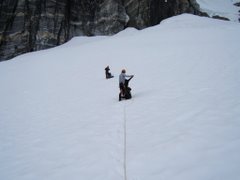Again, I am in the lab, sinking into the swivel chair in flourescent light optimism. My standards are all faring well today creating nice linear calibration curves---to accurately determine what is in my glacier samples... all is well so far (knock on plastic) in spite of the fact that the glass sample chamber was pink with other people's high concentration samples yesterday. Pink is the color of evil and iron oxidation. Anthony boiled the pink away in nitric acid, and my blanks are clean to the ppt. That's a few drops in the ocean. I'm also writing a paper. Its not taking long. Writing is the easy part... its the ICPMS that is the hard part. The instrument has so many special parts... the contamination of cones, the plugging of nebulizers, the settling of sediment...the paper is not taking long at all... I finished most of it last week...
To more adventures in science in the new year!
Subscribe to:
Post Comments (Atom)



2 comments:
Keeping ppt level of metals should be a marvelous job keeping environment,reagent purity and operator cleanliness. ICPMS parts are many but kept in place replaced at cost. ppt is everything..
P.Chandrasegaran.
Contamination is a major concern at every level. So true. This is evident in my filtration blanks---so my stream samples cannot be measured to the same low concentrations as the snow (the filters impart some of their dirt to each sample).
In the snow we use clean suits, techniques, ultraclean acids, labs and many blanks. As my advisor often pointed out in his trace metals course- It is critical to report methods and field and lab blanks in addition to instrument precision and accuracy when dealing with such low concentrations. Altough metal contamination is well documented, I'm surprised how many papers continue to publish possibly contaminated measurements...
Post a Comment